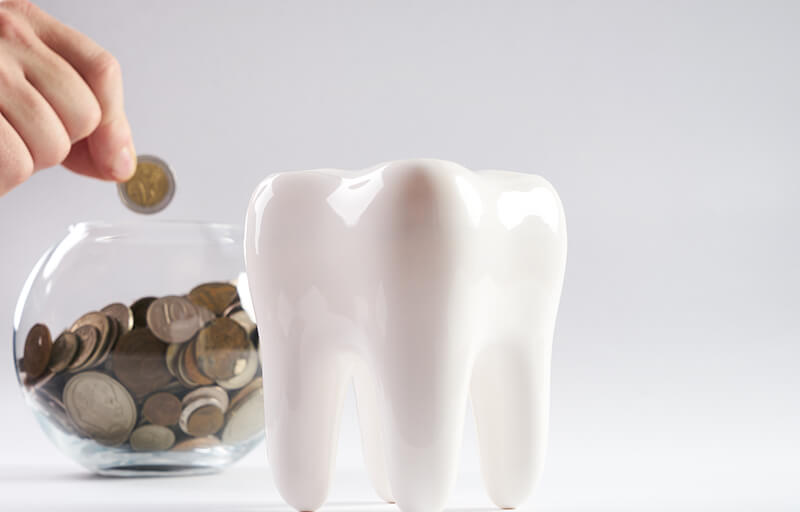The best way to save money on dental care is to see your dentist regularly. Preventive care, such as checkups and cleanings, can stop the development of expensive-to-treat oral diseases. When properly cared for, your teeth and gums can stay healthy for your entire lifetime, according to the most recent Surgeon General’s report on oral health in America. And studies have shown that for every dollar you spend now on preventive care, you may save $8 to $50 in restorative and emergency treatments later.
But those statistics aren’t helpful if you can’t afford dental treatment because you’re uninsured or underinsured. Read on to find out about dental plan options that can dramatically reduce the cost of dental care, and other ways to inexpensively manage your dental health.
See how much you can save with a dental savings plan.
Use our calculator below >
The importance of regular checkups and cleanings
A checkup and cleaning twice per year is often recommended, at about $200-$300 per visit. With dental insurance, your preventive care is usually covered at 100%. If you don’t have a dental plan, checkups and cleanings may seem expensive – until you consider the cost of not acting. If you develop a cavity, it costs an average of $200-$400* to have it filled. You may also need to factor in the cost of a dental exam with x-rays, and sedation/anesthesia as needed.
But if you let that dental decay progress untreated, the costs can mount quickly. The most common dental treatment performed on badly decayed teeth is a root canal, which typically costs $700 to $1,300*. The crown that you’re likely going to need after the root canal will cost an additional $800-1,000+*. If your tooth/teeth are beyond saving, dentures or dental bridges typically cost from $3,000 to $4,500*. A single dental implant, which is often the preferred treatment option as it can reduce bone loss in the jaw, can cost $2,450+.
Periodontal (gum) treatments, which may range from $600 to $2,000*, are often needed to restore oral health when an infection has set in. Most of the population of the U.S. will experience gingivitis (the mildest form of gum disease) at some point in their lives, while 30-40% of us will experience periodontitis (the severe form of gum disease). Bacterial plaque is the main cause of 90% of dental diseases, and treatment requires the removal of bacterial biofilm and its associated calculus (tartar) from the teeth and gums, as well as antibiotics in some cases.
You see the importance – for your health and your budget – of getting regular dental care.
Upgrade your oral hygiene routine
Consistently taking care of your oral health at home is critical to staying healthy and saving money.
You might think that vigorous brushing is more likely to remove food debris and just-forming plaque than a gentler approach. But the truth is that forceful brushing can damage dental enamel and gum tissue, resulting in cavities, tooth decay and gum disease.
Here’s a quick refresher course on cleaning your teeth: position your toothbrush’s bristles at a 45-degree angle to the surface of the teeth and brush gently in small circles. Be especially careful when brushing near your gums – hard, side-to-side brushing here can cause irritation that can lead to infection and receding gums. Rinsing with water or your favorite mouthwash can help to dislodge debris, along with flossing.
Dental savings plans vs. dental insurance
Both dental savings plans, and dental insurance can help you save money on your dental care. The big question is which plan is right for you.
For those on Medicare or without employer-provided dental insurance, a dental savings plan is often a great option. Plan members report saving an average of 50%** on their dental care.
Dental savings plans are the best way to lower the cost of expensive procedures, such as crowns, bridges, braces, implants, and dentures – even including treatments rarely included in dental insurance policies such as tooth whitening and other dental cosmetic care and dental implants. Routine care, like check-ups and cleanings are usually discounted too. You can start saving within 72 hours of joining (emergency immediate activations are available for some plans) and there are no annual limits on how much you can save.
If your primary goal is to reduce the cost of preventive care, dental insurance may be right for you. You pay a monthly fee, and in exchange, your cleanings and check-ups are typically covered at 100%. Many other procedures are discounted as well, after a deductible and waiting periods, if applicable, are met, until you reach your annual maximum which is typically $1000-$1500. If you exceed the annual limit, you’ll pay out of pocket for your dental care (and your monthly premiums) until your plan resets at the end of the plan year. You can also explore dental insurance for seniors to help reduce costs.
If you’ve been delaying a visit to the dentist because of cost, now is the perfect time to learn more about your dental plan options. And the perfect place to start is DentalPlans.com, the largest dental plan marketplace, with over 25 plans from the most trusted brands in healthcare. Use our find dentists near me option to see if your provider is in network, or accepts dental savings plans.
Call us at 1-833-735-0399 with any questions, or to receive a personalized plan recommendation. Want a quick look at how much you can save on your dental care? Use our calculator below.
*Cost average obtained from DentalPlans.com procedure search tool.
**Discount Health Program consumer and provider surveys indicate average savings of 50%. Savings may vary by provider, location, and plan.

